Mexican Hairless Ancient Dog: Xoloitzcuintli Dog Breed Information
The Xoloitzcuintli, rooted in Mexico’s ancient cultures, is a dog breed woven into the fabric of history and tradition. The Aztecs and Mayans held this dog in high esteem, believing it had special powers. It stands out with its hairless skin and, for some, a short coat. Understanding how to care for a Xoloitzcuintli properly is not as widely known. Maintaining their skin, diet, and exercise is vital to keeping them healthy today.
The breed is adaptable and has a unique personality. Health is essential to consider as they become more popular pets. The history and modern life of the Xoloitzcuintli offer much to learn and discuss.
The Xoloitzcuintli’s adaptability and character make it an intriguing pet. As it grows in popularity, we see more interest in its care. Its skincare is unique due to the lack of fur. A proper diet and regular exercise keep it in top shape. Its mix of ancient culture and modern living continues to spark curiosity and conversation.
Key Takeaways
- The Xoloitzcuintli thrives with proper skin care and diet.
- Owning a Xolo reflects a blend of ancient and modern lifestyles.
- Their unique, hairless appearance requires specific attention and knowledge.
The Xoloitzcuintli, rooted in Mexico’s history, demands specialized care. This breed, known for its hairless physique, needs a tailored skin regimen and nutrition. As a link between past and present, the Xolo continues to intrigue.
Quick Facts
The Xoloitzcuintli, also known as the ‘Xolo,’ is a hairless breed of dog from Mexico with a heritage spanning over 3,000 years. It’s known for its distinctive look and deep roots in Mexican history. The Xolo’s lack of hair, which some people with allergies appreciate, is due to a genetic trait that sometimes results in missing teeth. This breed comes in three sizes: toy, miniature, and standard.
The Xoloitzcuintli Club of America works hard to keep the breed thriving and to highlight its role in Mexico’s cultural legacy. Despite its long history, the American Kennel Club recognized the Xolo in 2011. The species is a source of national pride and a beloved pet in many homes worldwide.
Xoloitzcuintli Dog Breed Pictures
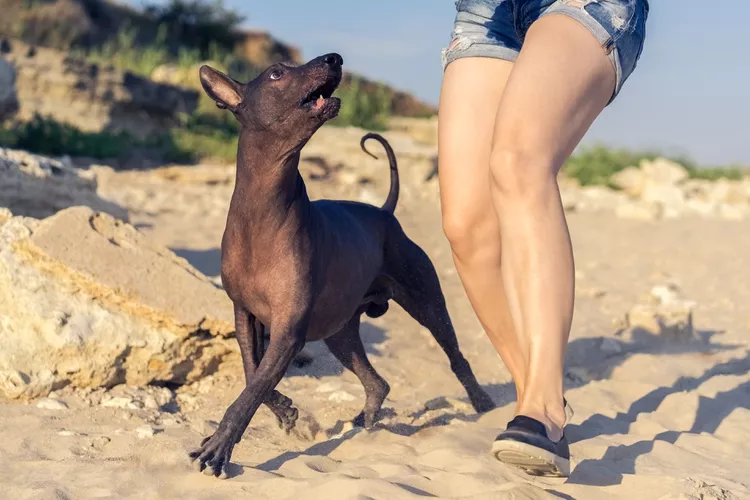
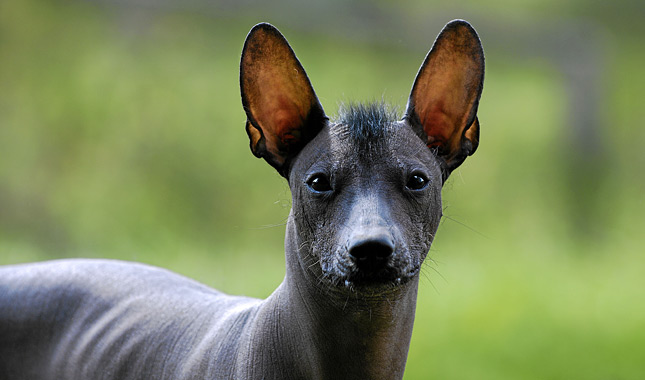
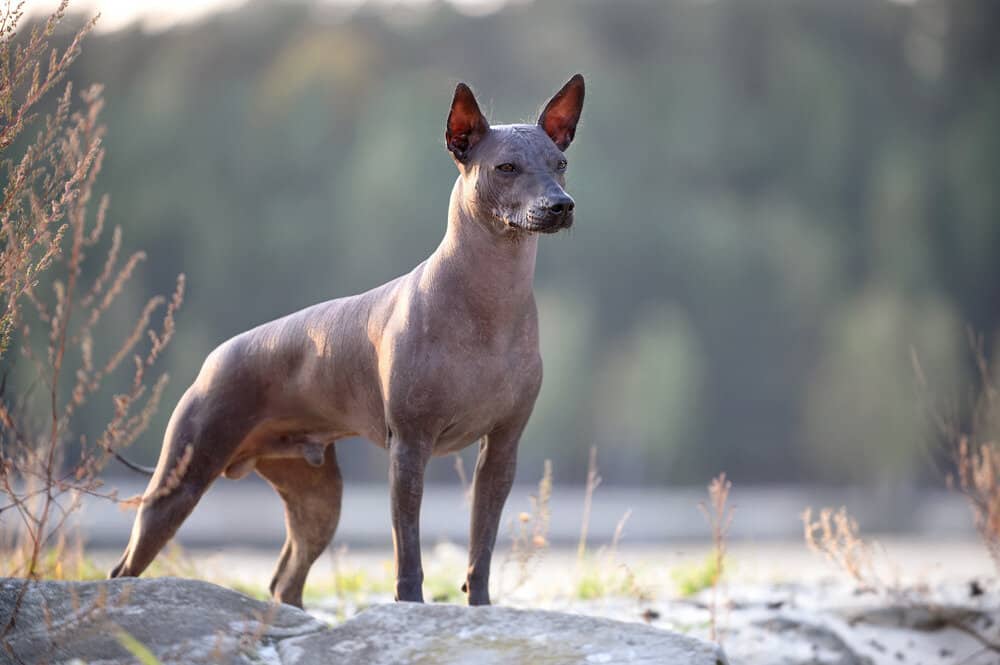
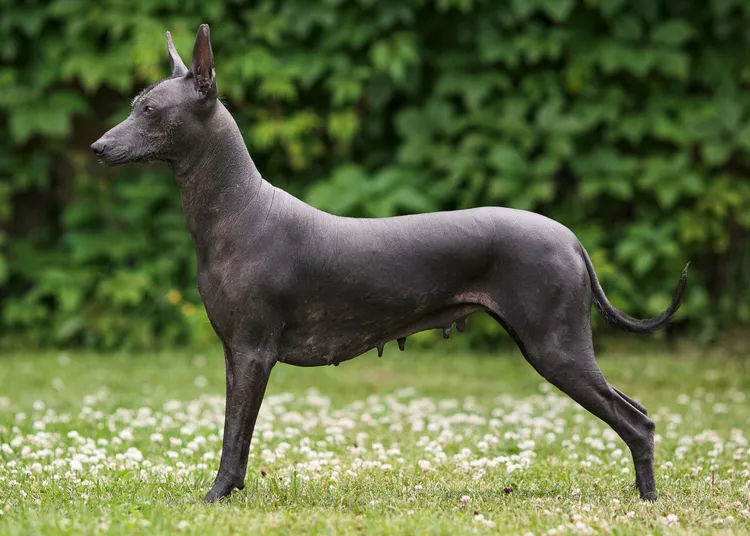
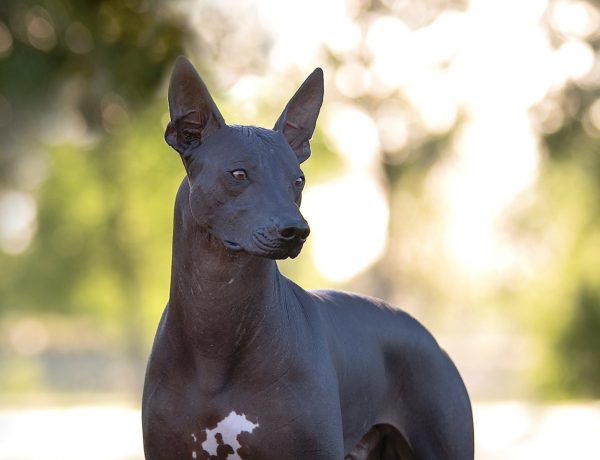
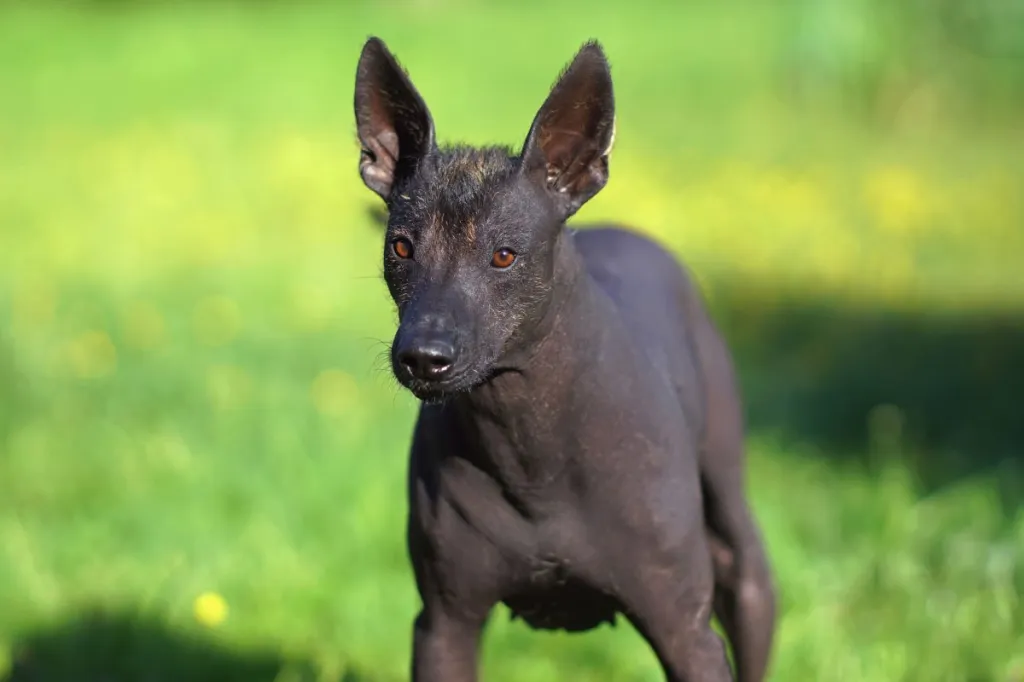
Overview
Building upon the rich heritage and unique characteristics of the Xoloitzcuintli, it is essential to explore the breed’s origins, cultural significance, and physical attributes to fully appreciate its status as an ancient companion and a modern pet.
The Xoloitzcuintli (pronounced ‘show-low-eats-QUEENT-lee’), revered by ancient civilizations such as the Aztecs and Mayans, has been a fixture in Mexico for over 3,000 years. With DNA sequences mirroring Old World canines, this breed was formally recognized by international kennel clubs and is distinguished by its genetic distinctiveness.
Available in three sizes—from toy to standard—Xolos exhibit a sleek body, almond-shaped eyes, and prominent bat-like ears. They come in hairless and coated varieties, spanning a range of colors, and are celebrated in art and popular culture, including Frida Kahlo’s paintings and the animated film ‘Coco.’
Cultural Significance
The Xoloitzcuintli has a deeply connected culture, making it more than just a pet but a revered emblem linked to spiritual practices. As the Aztec dog, this breed was believed to guide souls in the afterlife, explaining their presence in many ancient burial sites beside their owners. The breed’s long history stirs a blend of admiration and enchantment.
| Cultural Aspect | Emotional Resonance |
|---|---|
| Ancient Lineage | Awe and Respect |
| Spiritual Guide | Comfort and Intrigue |
| Healing Powers | Hope and Esteem |
| Ritual Importance | Ancestral Honor |
| Artistic Representation | Cultural Essence |
The legacy of the Xoloitzcuintli, symbolizing healing and safeguarding in both life and beyond, continues to elicit respect and ethnic pride.
The Xoloitzcuintli’s ancient origins are not only interior history buffs but are mean and those who cherish their pets as part of their heritage. This breed’s role as a companion and spiritual guide through life’s journey and beyond makes it unique. Their presence in art and rituals links us to our ancestors, reminding us of the deep bonds shared with these animals.
It’s not just about the past; the Xoloitzcuintli still holds a place exists sets and homes. They’re seen as more than just dogs but as keepers of a robust heritage. This connection is felt by those who own a Xoloitzcuintli and appreciate the cultural richness these dogs represent. Their story reminds them of the bond between humans and their animal companions.
Ancient Lineage of Pet Parents
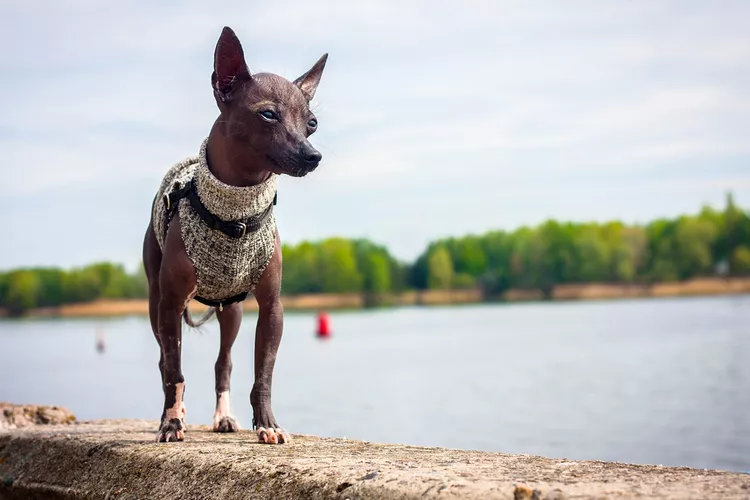
The Xoloitzcuintli is a dog with a rich history that goes back to ancient Mesoamerican civilizations. This breed has managed to maintain its original features and significance despite the many changes over the centuries. Here are some critical aspects of the Xoloitzcuintli’s long-standing heritage:
- Historical evidence shows that the Xoloitzcuintli was one of the earliest domesticated dogs in the Americas. Their existence is closely linked with ancient cultures such as the Aztecs and Mayans.
- These dogs were more than pets; they were considered spiritual guides and beloved companions in these early societies.
- Over thousands of years, the Xoloitzcuintli has adapted and evolved. Yet, it has kept the distinct characteristics and behavior that make it unique.
- Dog associations around the globe acknowledge the Xoloitzcuintli for its historical and genetic importance.
- There are ongoing efforts to preserve the breed’s distinct lineage. These efforts aim to prevent the Xoloitzcuintli from losing its unique genetic makeup.
In short, the Xoloitzcuintli is not just an ancient dog breed; it’s a living piece of history. Its survival and preservation are a testament to ia its enduring legacy and the dedication of those who value its past.
Pre-Columbian Origins
The Xoloitzcuintli has a history in Mexico that goes back over 3,000 years. Ancient civilizations like the Aztecs and Mayans valued this breed for its cultural importance.
The breed’s name combines ‘Xolotl,’ the name of an Aztec deity, with ‘itzcuintli,’ which means dog in Nahuatl. Genetic research supports the breed’s ancient roots, showing that the Xoloitzcuintli’s DNA is similar to that of dogs before Euns arrived in the Americas. This indicates that the breed developed without being mixed with dogs from other regions.
The breed was officially recognized by the FCI in 1956, and it continues to be a symbol of Mexico’s long and diverse history, predating European colonization.
Cultural Significance
The Xoloitzcuintli, with roots tracing back over three millennia, symbolizes history. Esteemed for its connection to the past, this breed has played a significant part in ancient religious ceremonies and social traditions.
The Mexican Hairless Dog is a living link to the indigenous peoples like the Aztecs and Mayans. It’s named after Xolotl, the Aztec god, and ‘itzcuintli,’ the Nahuatl, ‘erm for the dog, highlighting its old ties to early North American canine breeds.
The Xoloitzcuintli presents a Mexican legacy, and ongoing efforts are devoted to maintaining the breed’s distinctive and long-standing heritage.
Breed Evolution
The Xoloitzcuintli, often called Xolo, has a rich history. This dog breed is one of the oldest and most respected.
The Aztecs and Mayans held Xolos in highly regarded Xolosem as sacred and essential to their culture. Research into their genetics shows that Xolo’s DNA is similar to that of dogs from Europe and Asia, supporting their long history.
In the 1950s, the FCI and AKC formally recognized the breed, helped protect the Xolo’s future, and honored its past.
Physical Dimensions of Xolos
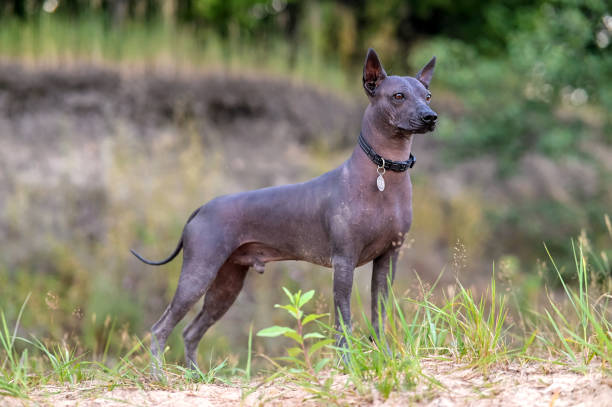
Understanding the Xoloitzcuintli’s physical traits is essential for breed standard compliance and maintenance maintenance. This breed varies significantly in size, which affects its role and adaptability to different environments. When assessing a Xoloitzcuintli, these are the main factors to keep in mind:
- Size Categories: There are three distinct groups – Toy, Miniature, and Standard.
- Weight: Each size group has its weight range.
- Height: Getting the height right is crucial for the dog’s classification.
- Body Shape: The breed has a unique body structure that should be considered.
- Breed Guidelines: This helps maintain the breed’s distinct features and ensure uniformity.
These aspects are vital for breeders and owners who want to ensure their pets are healthy and fit well into their homes. It’s not just about meeting standards; it’s about the well-being of these unique dogs.
Size Varieties
Xoloitzcuintlis come in three sizes to fit different homes and lifestyles. Whether you live in a small apartment or a spacious house, a Xoloa Xolo is for you.
The toy Xolo is perfect for those with limited space, weighing only 10-15 pounds and standing about 12 inches tall.
The miniature version, tipping the scales at 15-30 pounds, stands between 12 and 18 inches tall and offers a happy medium for those who want a dog that’s not too big or too small.
The standard Xolo, the largest of the three, weighs 30-55. The pond can grow up to 24 inches tall, making it an impressive and loyal addition to the family.
Each Xoloitzcuintli size shares common breed traits, including the unique option of a hairless or coated exterior, for hairline regular must be maintained for the hairless variety, eir health, and appearance.
Regardless of size, Xolos are known for their loyalty and intelligence, making them excellent pets for various owners.
Whether you’re you’reThe Xoloitzcuintli breed has something to offer, whether a small companion or a giant, more commanding pet, the Xoloitzcuintli breed has something to offer.
Weight Range
Understanding the Xoloitzcuintli’s weight is crucial for their health.
This unique breed, known for its smooth physique, distinctive eyes, and large ears, comes in three sizes, each with a different weight range.
The toy Xoloitzcuintli is the smallest, weighing between 10 and 15 pounds, which is ideal for people who want a small dog.
The miniature version is a bit larger, with a weight range of 15 to 30 pounds.
If you prefer a more giant companion, the standard Xoloitzcuintli weighs between 30 and 55 pounds.
With these options, the breed fits various homes and lifestyles.
Xoloitzcuintlis can be found in hairless and coated varieties within these size groups.
Owners should focus on their Xoloitzcuintlis’ health by taking special care of the hairless ones to prevent sunburn and keep their skin from drying out.
Height Measurement
Understanding the various sizes of the Xoloitzcuintli breed is essential for both breeders and dog owners. This breed comes in toy, miniature, and standard varieties, with heights ranging from 10 inches to 23 inches.
The toy Xolo is the smallest, standing between 10 and 14 inches tall at the shoulder. The miniature version is slightly taller, measuring from 14 to 18 inches.
The standard Xolo is the largest, attaining reachings. These height specifications are essential for meeting breed standards, especially for those aiming to compete in AKC events.
Body Proportions
Understanding the body proportions of the Xoloitzcuintli, or Xolo, is essential for their care. These dogs come in three sizes: toy, miniature, and standard. They range from a small 10 pounds to a more significant 55 pounds. Xolos can be hairless or coated, each with its shape and look.
Knowing their size helps to plan the right amount of exercise for their health. It also helps to see if they’ll fit nicely in a small apartment or need more space.
The Xolo’s size affects its exercise needs and how well it can live in different homes. For example, a small apartment might be OK for a toy Xolo but too cramped for a standard one. When choosing an Xolo, consider your pace and lifestyle to find the best match.
Breed Standards
Understanding the physical traits of the Xoloitzcuintli is crucial for breed enthusiasts and potential dog owners. The American Kennel Breed Club recognizes this unique breed in three sizes – the smallest being the toy variety, standing at 10 to 14 inches. The next size is the miniature, which stands 14 to 18 inches tall. The largest is the standard size, ranging from 18 to 23 inches in height. These dogs can weigh anywhere from a light 10 pounds to a more substantial 55 pounds.
The Xoloitzcuintli is known for its hairless skin and sleek, muscular build. They have striking almond-shaped eyes and large ears that stand up like those of a bat. While most are hairless, some puppies in a litter may have a coat of fur. This breed’s unique appearance makes it stand out at dog shows and draws the attention of dog lovers everywhere.
Temperament Traits
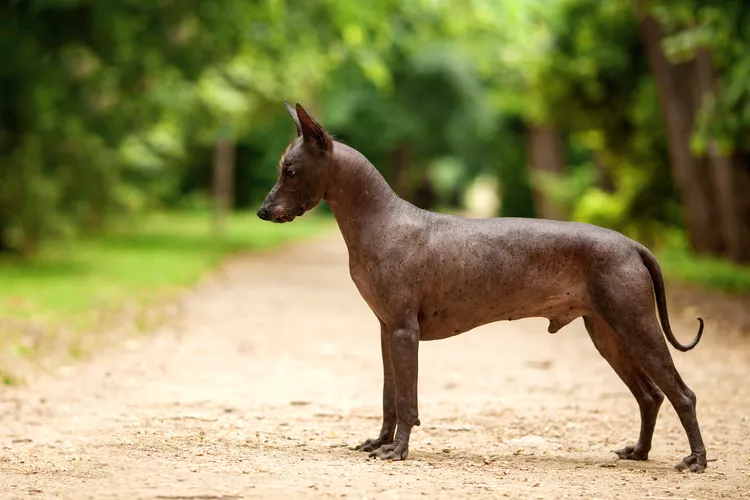
The Xoloitzcuintli, commonly known as the Xolo, is a dog breed with unique temperament traits that make it stand out as a companion. People considering getting an Xolo should understand these traits to build a strong relationship with this time-honored breed.
Xoloitzcuintlis is known for:
- Their deep loyalty creates a solid connection with their human owners.
- Their instinct is to guard their home, being watchful without being overly aggressive.
- Their love for being around their family or other household pets.
- Being hypoallergenic is beneficial for people with allergies.
- Having sturdy health affects their behavior and quality of life.
When considering a Xolo as a pet, it’s clear that their devotion to their family and their protective instincts are significant assets. Their friendly nature makes them great companions for both humans and other animals. For those with allergies, their hypoallergenic coat is a significant advantage. Their robust health often means fewer vet trips and more time to enjoy life together.
Loyal Companion Nature
Xoloitzcuintlis is the very definition of a faithful friend, known for their unwavering dedication to their families and their sharp instinct to guard their homes. These dogs are naturally inclined to watch over their territory, alert and ready to protect.
The connection between a Xolo and their human is deep, showing through their caring and affectionate behavior. Their consistent loyalty sets them apart, making them exceptional in supportive roles like therapy or as service animals. They are attuned to human feelings, a valuable trait in such work.
Xolos love without condition and flourish in a loving family environment, providing reliable and nurturing companionship.
Watchdog Versus Guard
When discussing the difference between a watchdog and a guard dog, it’s vital to recognize that Xoloitzcuintlis are sharp and good at warning their owners about strangers. Still, they usually don’t have the aggressive traits seen in guard dogs.
The Xoloitzcuintli’s nature is more of a devoted and protective buddy than a bold defender with an intense chase instinct. Their knack for being attentive makes them exceptional watchdogs, ready to inform their people of anything odd quickly.
Xolos build deep connections with their humans and show friendliness to those they know well, including other pets. This highlights their role as dogs that alert rather than confront.
Their moderate need for physical activity and ability to adapt to different homes make them perfect for families looking for a watchful but gentle pet.
Pack Animal Dynamics
Understanding how Xoloitzcuintlis behave in a group sheds light on their loyalty and friendly nature. These traits lead to strong connections within their family and a cautious but aware approach towards new people. As a breed known for companionship, Xolos show a welcoming warmth to those living with them, making them ideal pets. They are also protective without being excessively aggressive, making them good guard dogs.
Xoloitzcuintlis are clever and keen to learn, allowing them to do well in activities like obedience and therapy work. There are both hairless and coated varieties of Xolos, and they come in sizes ranging from toy to standard. This means people with different needs and living conditions can find the right Xolo.
Allergy-Friendly Breed
For people with allergies, the Xoloitzcuintli is an excellent choice. This breed sheds very little, and some don’t have hair. Hairless Xoloitzcuintlis are especially good for those allergic to pet dander, which is often the cause of allergic reactions. Even Xolos with coats have short, smooth fur that doesn’t produce much anger. This makes them suitable for people with mild dog allergies. However, spending time with an Xolo before getting one is best to ensure it doesn’t trigger your allergies. Besides being allergy-friendly, Xoloitzcuintlis are also intelligent and loyal. They make great pets for those looking for a low-allergen dog.
It’s crucial to consider individual allergies when choosing a dog. Xolos can be an excellent fit for many, but spending time with one first is critical. Their intelligence and loyalty make them more than just allergy-friendly dogs. They are also loving and easy to train, perfect for someone needing a faithful pet.
Xoloitzcuintli | Allergy-Friendly | Minimal Shedding | Intelligence | Loyal Companion
Robust Health Profile
The Xoloitzcuintli, with its low shedding, is a good choice for those with allergies. Their health is generally robust due to an excellent genetic makeup with minimal inherited issues. Xoloitzcuintlis are resilient and full of life.
Skin care is essential for hairless types to avoid sunburn and dryness. This includes baths, moisturizing, and sunscreen. They do well in warm weather but might need extra warmth when it’s cold.
Keeping them healthy means regular vet visits and up-to-date shots. Protecting their genetic diversity is also crucial, as bad breeding can cause problems. These steps help keep the Xoloitzcuintli breed healthy for the future.
Xolos Require: Wellness and Longevity
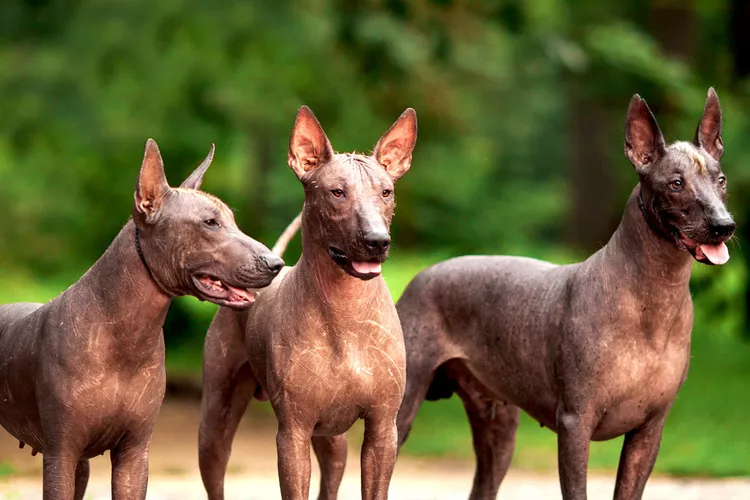
The health and long life of the Xoloitzcuintli, commonly known as the Xolo, depends on several factors that caretakers need to consider for their pet’s optimal health. A holistic health plan, preventive care, and a diet tailored to their specific life phases are vital.
Here are critical points for maintaining Xolo’s well-being:
- Owners should provide a balanced diet suitable for the dog’s age, size, and activity.
- A regular exercise routine should match their moderate energy and keep them fit.
- Xolos need a warm living space because they are sensitive to the cold.
- Hairless Xolos require a regular skincare routine to avoid skin problems.
- Regular vet check-ups help catch and prevent health issues early on.
Healthy Breed: Health Maintenance Tips
Regular visits to the vet and timely immunizations are vital for maintaining the health of a Xoloitzcuintli and preventing diseases. This breed is not only historically significant but also generally robust. However, following a healthcare routine that supports their needs is vital.
Skincare is essential for hairless Xoloitzcuintlis. Owners should be careful not to irritate the skin with too much washing or lotion application. Using sunscreen and moisturizers helps shield their skin from sun damage and keeps it from getting too dry.
Regular, breed-specific exercise is essential, but these dogs don’t do well in the cold. Keeping to these practices helps the Xoloitzcuintli lead a healthy life while showcasing their famed loyalty and smarts.
Diet for Longevity
For the health maintenance of Xoloitzcuintlis, a nutritious diet is vital. These dogs thrive on balanced meals that include lean meats, good fats, and all the necessary vitamins and minerals they need. They must get fresh, high-quality food daily, tailored to their unique needs. This could be a raw diet or one that’s commercially available.
Careful attention to the amount of food and how often they eat, adjusted for their age, size, and how active they are, is a must for their health. Along with constant access to clean water, a vet’s recommendation for occasional vitamins or minerals can also help keep Xoloitzcuintlis healthy for years to come.
Preventive Care Essentials
To ensure a Xoloitzcuintli’s health and long life, owners should give them regular preventive care. This means taking them to the vet often to stay up-to-date on shots and catch any potential problems early, like knee issues common in dogs.
Skincare is essential for hairless Xolos. They need baths with gentle shampoos, regular moisturizing, and sunscreen to protect their skin from the sun.
Keeping your dog at a healthy weight is critical. A good diet and the right amount of exercise can help prevent joint problems related to being overweight.
Getting genetic health tests for your dog is also a good idea. This can tell you if they might get certain diseases so that you can look after their health better.
A happy and healthy Xoloitzcuintli also needs good socialization, proper dog training, and a safe living place.
Make Great: Grooming and Maintenance
Whether hairless or coated, caring for Xoloitzcuintli dogs is vital for their well-being. Proper grooming ensures these distinct dogs stay healthy and comfortable. When looking after these pups, consider their unique needs, like skincare and dental hygiene. Here are some tips for their consideration:
Bathing and moisturizing hairless Xoloitzcuintlis is essential to avoid sunburn and prevent their skin from becoming too dry. Choose hypoallergenic products and apply sunscreen to keep their skin healthy.
For those with a coat, regular brushing keeps shedding under control.
Both types of Xoloitzcuintlis need their toenails trimmed, and teeth brushed consistently. A good skincare routine is also essential. Wipe them with a damp cloth to clear away dead skin, and after a bath, apply a gentle moisturizer.
Hairless Xolo Skin Care
Maintaining the health of a hairless Xoloitzcuintli’s skin is crucial due to its lack of fur. They need careful attention with routines that include regular baths, moisturizing skin, and protecting them from the sun. These steps are necessary to keep their skin in good shape.
Bathing a Xolo should be done using gentle, skin-friendly products that won’t irritate. After their bath, applying a moisturizer made for sensitive skin will help keep it from getting dry. When your Xolo spends time outdoors, don’t forget to apply sunscreen to protect against sunburn. However, bathing too often can remove essential oils from their skin.
Finding the right balance in skin care is essential to avoid problems. Have your Xolo checked by a vet often to catch any skin issues early. Doing so lets you keep your Xolo’s skin healthy and avoid complications.
Coated Variety Brushing Needs
A coated Xoloitzcuintli requires regular brushing to keep its sleek coat in top condition and reduce shedding. Proper grooming goes beyond looks; it helps spread the dog’s natural oils to protect its skin. Use a gentle brush that won’t harm the skin or strip away these essential oils.
Giving your Xolo occasional baths with mild shampoo will keep their coat fresh without drying out their skin.
Nail trimming and dental care are also vital for a coated Xoloitzcuintli. Keeping the nails short prevents discomfort and helps with your dog’s movement. Regular teeth cleaning is essential to avoid dental issues and promote overall health.
Bathing Frequency Tips
Caring for a Xoloitzcuintli, whether hairless or coated, involves a delicate balance in their bathing routine. It’s essential not to over-bathe for the hairless variety, as doing so removes the natural oils that protect their skin. A monthly bath or two is sufficient. It’s vital to apply a gentle moisturizer post-bath to keep their skin safe from sunburn and to prevent it from becoming too dry without blocking their pores.
Coated Xoloitzcuintlis, however, might need baths based on how much they shed to keep their coat in good condition. Using hypoallergenic products is critical for hairless and coated dogs to avoid irritating their skin.
When it comes to hairless dogs, sun protection is a must if they’re going to be outside for a while to help maintain their skin’s natural defenses.
Nail Trimming Guide
Taking care of your Xoloitzcuintli’s nails is vital for their well-being and comfort. This hairless breed is especially susceptible to skin issues, so you must be careful not to scratch or tear their skin when trimming their nails.
Keeping nails short is necessary for all sizes of Xolos – toy, miniature, or standard – to prevent discomfort and issues with walking and posture.
Use the right tools, like dog-specific nail clippers or grinders. Aim to trim your Xolo’s nails every three to four weeks, but be cautious not to cut them quickly, which can be painful and cause bleeding.
Always end the nail-trimming process on a high note with a treat or praise, making it a positive experience for your intelligent and loyal pet.
Dental Hygiene Practices
Taking care of your Xoloitzcuintli’s nails is essential for their comfort, and looking after their teeth is just as important to avoid dental diseases and maintain their health.
Brush their teeth with a soft toothbrush and toothpaste made for dogs two to three times a week to prevent gum disease and tooth decay.
Give your Xolo dental chews and toys to help control plaque and tartar.
Watch for signs of dental problems, like foul breath, which could signal a more serious issue.
Feed them a diet that supports dental health and offer treats that help clean their teeth.
If you notice any dental issues, take them to the vet for professional care.
Dogs in the Americas: Dietary Requirements
Caring for a Xoloitzcuintli’s diet is critical to keeping them healthy and energetic. A well-thought-out meal plan can prevent common health issues and cater to their unique needs. Here’s what you should keep in mind:
- Xolos need meals packed with nutrients that match their age and activity level. For those prone to food sensitivities, choosing hypoallergenic food is wise. Sticking to a regular feeding routine helps their digestion stay on track.
- Watch their food intake to avoid weight gain, and know which foods could be harmful to prevent health problems. It’s about finding the right balance for your pet’s diet to ensure they thrive.
Balanced Nutritional Needs
Proper nutrition is vital for a Xoloitzcuintli’s health and energy. A diet rich in proteins, fats, carbs, vitamins, and minerals is critical. Dog owners should get a vet-recommended diet that fits their pet’s age, size, activity, and health. Fresh water is a must for hydration and body functions.
Keeping an eye on Xolo’s weight is essential to prevent overweight or malnutrition issues. You might need to tweak their food amounts accordingly. A mix of top-quality store-bought dog food and safe homemade dishes can keep your Xolo healthy.
Good nutrition supports a longer, healthier life for your pet.
Prey Drive: Allergen-Free Food Options
When it comes to feeding a Xoloitzcuintli, it’s vital to consider balanced nutrition and allergen-free options for the dog and people with allergies.
The hairless variety of Xoloitzcuintli is often a good fit for those with allergies, as they tend to shed less and cause fewer reactions.
Owners must meet their Xoloitzcuintli’s dietary needs while caring for their skin through regular grooming.
This approach helps to keep allergens at bay and supports an allergen-free home for everyone involved.
Feeding Schedule Importance
Creating a regular feeding schedule for Xoloitzcuintli dogs is very important. It ensures they get the right mix of nutrients for their age, how much they exercise, and their health needs. A regular meal routine is vital in keeping these dogs healthy. It helps avoid issues like obesity, digestive problems, and bad behavior, making it easier for owners to train and control portions.
Sticking to a set mealtime is suitable for managing a Xoloitzcuintli’s diet and lets owners keep an eye on how much their dogs eat. Paying close attention to a dog’s appetite is necessary because changes could signal health problems. So, having a structured meal plan is vital for caring for these dogs and meeting their specific food requirements.
